
Treating Burns Page Selection Menu: 1 2 3 4 5 6 7 8 9 10 Next>>
Treating Burns During the Golden Age of Piracy, Page 3
Battle Burns
"We know by our experience, that Burning by Gun-powder and other materials do too frequently happen at Sea...." (Richard Wiseman, Of Wounds, Severall Chirurgicall Treatises, p. 439)
Accidental Burns - Loose Powder
Weapons during the golden age of piracy were all black powder ignited.
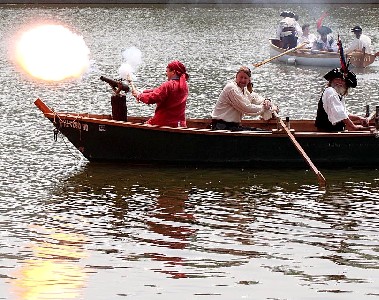
Photo: Don Carpenter
Your Author Firing the Deck Gun on the Green Black Sheep
The first thought most people have when considering black powder burns probably has something to do with being shot. However, it was more likely to sustain accidental burns resulting from the handling of your own weapon. Black powder has the disadvantage of being composed of fine, granular bits of powder which get everywhere when you're loading, and more particularly, priming a gun. This loose powder can readily be ignited by the sparks kicked out of the gun as it fires.
I know this from being in charge of firing the small deck gun aboard Mark Gist's boat The Green Black Sheep during mock battles. When preparing a gun to fire, you first put the appropriate amount of powder down the muzzle of the gun. This can be done with raw powder, although Mark uses foil-wrapped powder to avoid getting powder scattered about.
Once this is done, the touchhole on top of this gun must be loaded with loose powder from a powder flask. I don't care how careful you are doing this, some of that powder winds up getting scattered around, usually on the bottom of the boat. As you will notice in the photo above, there is quite an explosion of ignited powder, both from the gun's maw and the touchhole. I have several burns in my long-sleeved waistcoat and various long-sleeved shirts that bear witness to this. I have also accidentally set fire to the black powder that collected on the bottom of the boat on occasion. (It creates quite an alarming flash.)
Period documents don't tend to give a lot of details of such loose powder ignition occurring,
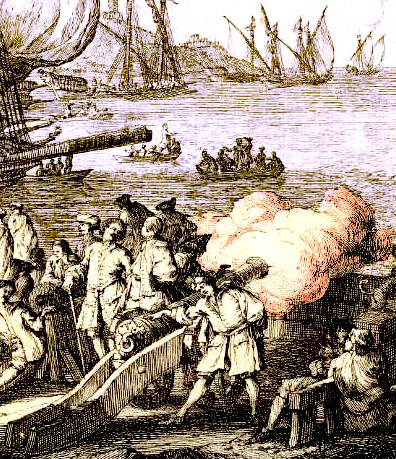
Artist: Jacques Rigaud Jacque
Gun Crew Firing, Alere au Depart Avec Coup de Canon (1750)
perhaps because it was only to be expected. However, merchant ship captain Thomas Phillips does state that during an engagement with a French privateer, "five or six of my best men were dreadfully blown up by their carelessness, in laying the lighted matches among some cartridges of powder"1. As if to make up for this lack of evidence, several modern authors do mention the problem.
In his excellent book Medicine Under Sail, Zachary Friedenburg explains,
Gun crews suffered scorches from spilled gunpowder scattered on the deck around the gun carriage and ignited by a shower of sparks when the gun was fired. Excess powder around the touchhole of a cannon could flare and burn those nearby. Other accidents occurred when gunpowder rammed down the muzzle of the cannon when burning material from the previous firing still smoldered inside the gun, would explode prematurely causing severe burns. Sometimes the barrel itself exploded and fragments of metal ripped across the deck.2
In addition to sparks from a firing cannon, the 'wick' used to fire the cannon - also called a match - could also be a potential source of accidental ignition. Vice-Admiral Sir James Watt explains the slow match as "a length of braided hemp impregnated with saltpeter which allowed it to burn continuously. When the arquebusier or gunner was ready to fire, he blew on the end of his slow match to make it glow, then applied it to the powder in the touch hole or the pan of the matchlock. In the excitement of battle the slow match ignited more than gunpowder in the gun."3
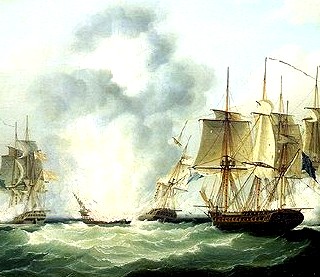
Artist: Francis Sartorius
From Four Frigates Capturing Spanish Treasure Ships (1807)
Perhaps the worst case of accidental powder lighting occured when the powder container caught fire. Captains Coxon, Harris and Sawkins were attacking a Spanish fleet of men-of-war and firing at one of ships, when "on a sudden we saw his men blown up that
were abaft the mast, some of them falling on the deck, and
others into the sea. This disaster was soon perceived by their
valiant Captain Peralta; but he leaped overboard, and, in spite
of all our shot, got several of them into the ship again, though
he was much burnt in both his hands himself. But as one
misfortune seldom cometh alone, mean while, he was recovering
these men, to reinforce his ship withal, and renew the fight,
another jar of powder took fire forward, and blew up several others upon the forecastle."4 This accident allowed the buccaneers to take the Spanish ship. The author reported that many men in the accident were "horribly burnt with powder, insomuch, that their black skins
were turned white in several places, the powder having torn it from their flesh and bones."5
1 Thomas Phillips, 'A Journal of a Voyage Made in the Hannibal', A Collection of Voyages and Travels, Vol. VI, Awnsham Churchill. ed., p. 181; 2 Zachary B. Friedenberg, Medicine Under Sail, p. 22; 3 Vice-Admiral Sir James Watt, "The burns of seafarers under oars, sail and steam", Injury: the British Journal of Accident Surgery, Vol. 12, p. 77-8; 4 Alexandre Exquemelin, The Buccaneers of America, 1856 Edition, p. 200; 5 Exquemelin, ibid.
Accidental Burns - Exploding Ordnance
Another accidental source of burns came from exploding guns and cannon. This could

From Famous Privateersmen and Adventurers of the sea,
by Charles H. L. Johnston, p. 289 (1911)
occur when the guns were overloaded or overheating from being rapid fired, straining the "carriage, breeching, tackles and sidebolts, with increased recoil and often [causing] overturning and explosion... Failure to ram home the shot on the head of the cartridge in the heat of action caused the gun to burst or be dismounted, and all these factors operated in sea battles causing numerous burns, wounds and factures, while shot fired from the short muzzles of the deadly British cannonades, or 'smashers,' as they were familiarly called, often set fire to the ship's own sails or rigging in spite of wetting the sails during action."1
Edward Coxere explained that a gun on a captured French ship, "shattered, [so] that when the gun was fired the powder took fire and blew away Edward Moor's beard and hair and burnt his hands, that his nails were like latern-horns. I undertook to be his surgeon, to 'noint him with tallow candle, and tied his hands up in rage for about eight days' time, having no other salve."2
1 Vice-Admiral Sir James Watt, "The burns of seafarers under oars, sail and steam", Injury: the British Journal of Accident Surgery, Vol. 12, p. 77; 2 Edward Coxere, Adventures by Sea of Edward Coxere, p. 42
Accidental Burns - Lionel Wafer
Perhaps the
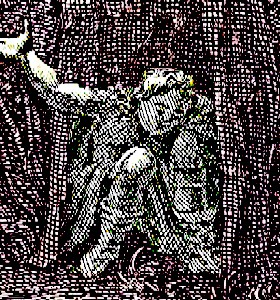
Lionel Wafer, from Reystogten Rondom de Waereldt,
Vol. 3, p. 66 (1717)
most famous accidental pirate burned during the golden age of piracy (if it's possible to be famous for such a thing) is surgeon Lionel Wafer. In all fairness, Wafer was considered to be more of a buccaneer than a pirate and more of a rapidly promoted surgeon's mate than a true surgeon. These things aside, however, he was burned because of a black powder incident. What followed allowed him to write an entire book about his experiences which became a best-seller.1
A group of buccaneers were trooping across the Isthmus of Panama from the Pacific side to the Atlantic. They had just crossed a river and were stopping to dry themselves by a fire built for that purpose. As Wafer explains:
It was the 5th day or our Journey when this Accident befell me; being also the 5th of May, in the Year 1681. I was sitting on the Ground near one of our Men, who was drying of Gunpowder in a Silver Plate: But not managing it as he should, it blew up, and scorch’d my Knee to that degree, that the Bone was left bare, the Flesh being torn away, and my Thigh burnt for a great way above it. I applied to it immediately such Remedies as I had in my Knapsack: And I being unwilling to be left behind my Companions, I made hard shift to jog on, and bear them Company for a few days...2
William Dampier, who was with the group making the crossing gives a slightly different account of the event, explaining
that Wafer "came to a sad Disaster here; being drying his Powder, a careless Fellow passed by with his Pipe lighted, and set fire to his Powder, which blew up, and scorched his Knee"3. While who was drying powder isn't really relevant to our purposes, it is a notable difference. One would think Wafer
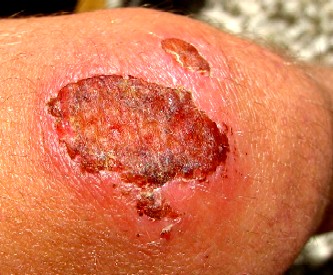
A Healing Knee. Perhaps Like Wafer's Was. (OK, gross and
only marginally relevant, but you get what you pay for.)
would give the more accurate account, but since these are the only two versions, it can't be said for certain.
Dampier goes on to worry "that he [Wafer] was not able to march; wherefore we allowed him a Slave to carry his things, being all of us the more concern’d at the Accident, because liable our selves every Moment to Misfortune, and none to look after us but him."4 Dampier feared that if Wafer was not with their group, they would have no surgeon during the journey, which is an interesting comment on the importance of surgeons.
Wafer finally had to admit that he couldn't keep up with the crew with his knee being so badly burnt and decided to stay behind with the Kuna Indians where "having no means to alleviate the Anguish of my Wound, the Indians undertook to cure me; and apply’d to my Knee some Herbs, which they first chew’d in their Mouths to the consistency of a Paste, and putting on a Plantain-Leaf, laid it upon the Sore. This prov’d so effectual, that in about 20 Days use of this Poultess [poultice], which they applied fresh every Day, I was perfectly cured; except only a Weakness in that Knee, which remain’d long after, and a Benummedness which I sometimes find in it to this Day."5
1 Jay Scriba, "The Pirate Who Wrote a Best-Seller", Milwaukee Journal, October 9th, 1970, p. 20; 2 Lionel Wafer, A New Voyage and Description of the Isthmus of America, p. 36-7; 3 William Dampier, Memoirs of a Buccaneer, Dampier’s New Voyage Round the World -1697-, p. 20; 4 Dampier, ibid.; 5 Wafer, p. 38-9
Fire Weapons - Fire Balls
One way to successfully take a ship was by burning it. As has already been noted, ships were highly flammable environments so fire was a very effective weapon when attempting to subdue a crew. In a battle with a Spanish ship in 1710, privateer Woodes Rogers reported that their "Enemy threw a Fire-ball out of one of her Tops, which lighting upon our Quarter-deck, blew up a Chest of Arms and Cartouch Boxes all loaded [Cartouche boxes were small boxes used to carry powder], and several Cartridges of Powder in the Steerage, by which mean Mr. Vanbrugh, our Agent, and a Dutchman were very much burnt; it might have done more Damage, had it not been quench'd as soon as possible."1

Shooting Fireballs From the Tops of a Ship, 16th Century
In his 1691 book on naval weapons, John Seller explains how to make such weapons.
Fire-Pots and Balls to throw out of Mens hands may be made of Potters-Clay with Ears to hang lighted Matches to them; if they light on a hard thing they break and the Matches fire the Powder, and the half Musket Bullets contrived on them... disperse and do much mischief.
Their mixture is of Powder, Petre, Sulpher, Sal Armonaick of each one pound, and four Ounces of Camphire pounded and searced and mixed well together, with hot Pitch, Linseed Oyl or Oyl of Petre; prove it first by burning a small quantity, and if it be too slow add more Powder, or if it be too quick then put more Oyl or Rosin, and then it is for your use."2
It was a nasty mixture, to be sure. You can readily imagine the burns such a weapon might inflict if thrown well. However, when you consider the pirates reason for taking ships - to steal the cargo - you may begin to suspect that they would be unlikely to use it to try and set fires in ship-to-ship battle. Of course their opponents would not have such concerns.
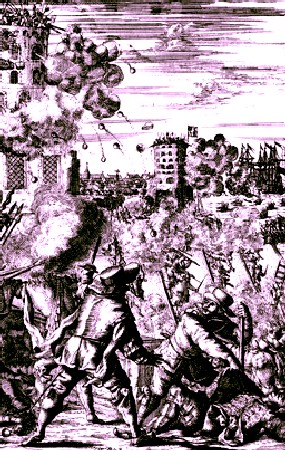
Morgan's Men Throwing Fireballs at Porto Ville,
from De Americaensche Zee-Roovers (1678)
Land battle was a different matter, however. The pirate l'Olonnais used fire-balls to help in the taking of the Spanish town of San Pedro. Upon encountering Spanish resistance on their way to the town, by "continually throwing little fire-balls in great numbers, for some time, forced this party as well as the former to flee, and this with so great loss of men, that before they could
reach the town, the greatest part of the Spaniards were either killed or wounded."3
Captain Henry Morgan tried a similar strategy at the castle of Puerto Bello with less success. "[T]he pirates perceiving they had lost many men... made use of fire-balls, which they threw with their hands, designing to burn the doors of the castle: but the Spaniards from the walls let fall great quantities of stones, and earthen pots full of powder, and other combustible matter, which forced them to desist."4
While temporarily defeated, reports of another group of buccaneers' success heartened the group, causing them to build ladders to lean up against the castle wall. Then "the pirates mounted them in great numbers, and with not less valor, having fire-balls in their hands, and earthen pots full of powder; all which things, being now at the top of the walls, they kindled and cast in among the Spaniards."5 Morgan used fire-balls in several similar land battles during his harassment of the Spanish coastal towns.
Perhaps the most bizarre use of a fire-ball type weapon was during Morgan's attack of the castle at Chagre. The buccaneers were not doing very well using fire-balls and hand weapons, when a man who was "wounded with an arrow in his back... pulled it out boldly at the side of his breast, and winding a little cotton about it, he put it into his musket, and shot it back to the castle; but the cotton being kindled by the powder, fired two or three houses in the castle, being thatched with palm-leaves... this fire meeting with a parcel of powder, blew it up, thereby causing great ruin, and no less consternation to the Spaniards, who were not able to put a stop to it, not having seen it time enough."6
1 Woodes Rogers, A Cruising Voyage Round the World, p. 161; 2 The Sea Gunner, John Seller, 1691, gathered from the internet, 4/25/13; 3 Alexandre Exquemelin, The Buccaneers of America, 1853 Edition, p. 81; 4 Exquemelin, p. 104; 4 Exquemelin, p. 105; 6 Exquemelin, p. 138
Fire Weapons - Granadoes and Stinkpots
Another fire weapon, one that would seem more more likely to be used by pirates because it had less risk of setting fire to the entire ship (and thus the cargo) was the granado or grenade. As
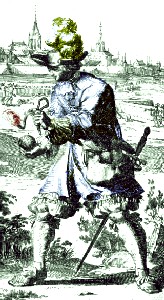
Artist:
Alain Manesson Malle
Lighting a Granado, from Les
Travaux de Mars, v. 3,
p. 133 (1684)
John Seller explains, in battle "good use [can be] made of Hand-Granadoes in Assaults and Boarding of Ships,"1 something the pirates would do. These also had the potential to cause burns, although if they were effective, their shrapnel would make the healing of any such burns irrelevant.
Looking at it from a military point of view, Vice-Admiral Sir James Watt explains that such "Hand grenades were commonly thrown from the tops or lobbed through ports of enemy vessels in the hope of setting alight loose powder, exploding boxes of cartridges or, better still, exploding the magazine."2 Again, this better reflects the aim of the military in destroying an enemy ship than it does the that of the pirates, who would usually prefer not to 'fire a ship' until they had achieved their aim.
Seller gives us another splendid description of how such devices were prepared during the period as well.
...these are made upon a Mould made with Twine, and covered over with Cartridge Paper and Musket Bullets cut in two, put with Past and bits of Paper thick on the out-side. After you have doubled the Shells, past on some at a time, and let it dry, and put some more until it be quite full; then dip it in scalding Rossen or Pitch and hang it up and it is for your use: But you must have the innermost end of the Twine left out, and before you pitch it you must draw out the Twine and stop the hole, and then [put] pitch [in] it.To load them, fill these Shells with Gun-Powder, then make a Fuze of one pound of Gun-Powder and six Ounces of Salt-Petre and one of Charcoal, and fill the Fuze; then knock it up to the head within one quarter of an inch, which is only to find it by night.
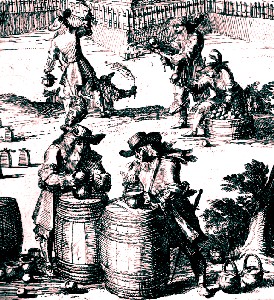
Artist: Alain Manesson Malle
Making and Throwing Fire Weapons, from Les
Travaux de Mars, v. 3, p. 135 (1684)
Stop the rest of the holes well with soft Wax; your first Shells must be coated with Pitch and Hurds [coarse fibres and other remnants of flax and hemp] lest it should break with the fall; and be sure when you have fired the Fuze, suddenly cast it out of your hand, and it will do good execution.3
In 1686, a group of buccaneers off Panama went after a small fleet of three ships, throwing "a great many grenades into their biggest ship, one
of which had so good an effect as to set fire to some loose powder they had, which burnt a great many men, and this
brought the fight to end sooner than otherwise could have been
expected"4.
Similar to granades were stinkpots, which were lit and thrown onto the decks of the enemy ship. These were earthenware containers which contained things like sulphur, gunpowder, nails, and shot as well as noxious-smelling materials meant to smother its enemies and chase them out into the open for easier shooting. While engaged in a battle with a Turkish ship in the Mediterranean on May 22, 1681, naval sailor Samuel Atkins described the damage stinkpots could do. "The mischeife to our men received, was eight killed outright, two dismembered, and forty-three others wounded, of which two dyed ye next day, and many others expected to have ye same fate, the stinkpots supposed to be throwne into our gun-roome, which gave fire to two cartouches of powder, having greatly injured most of ye poor men there; of ye men killed ye Captaine and gunner were two."5
1 John Seller, The Sea Gunner, gathered from the internet, 4/25/13; 2 Vice-Admiral Sir James Watt, "The burns of seafarers under oars, sail and steam", Injury: the British Journal of Accident Surgery, Vol. 12, p. 72; 3 Seller, ibid.; 4 Alexandre Exquemelin, The Buccaneers of America, 1853 Edition, p. 384; 5 Samuel Atkins, "A Sailor's Journal", Colburn's United Service Magazine, Part 1, 1854, p. 214
Fire Weapons - Fire Ships
A rather drastic weapon which was sure to cause burns and mostly likely the destruction of the ship it was set against was the fire ship. This was a vessel that was specifically designed to be lit when it got near the enemy with the idea that the two ships would get near enough for the flames of the fire ship to reach the opponent's vessel and set it alight as well.
Buccaneer Henry Morgan successfully used such a fire ship in 1669 to attack the Spanish ships waiting for him at Maracaibo. He did it by sending the fire ship out at the head of his fleet to make the Spanish believe it was "
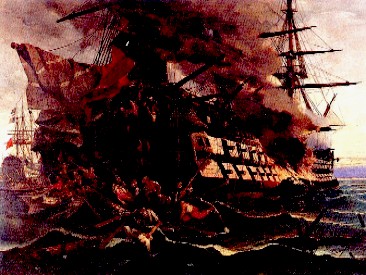
Artist: Konstantinos Volanakis,
Use of a Fire-Ship in an Attack (18th c.)
one of our best men-of-war going to fight them."1 The fire-ship "fell presently upon the great ship, and grappled her; which the Spaniards (too late) perceiving to be a fire-ship, they attempted to put her off, but in vain; for the flame seizing her timber and tackling, soon consumed all the stern, the fore part sinking into the sea, where she perished."2 The Spaniards on a second ship, seeing the danger, sunk their ship to avoid capture while a third ship was caught by the pirates.
Edward Barlow describes the use of three fire-ships against the English warship The Henry in 1666. The ship's commander, Sir John Harman "having had three fireships on board of him [sent at him] from the 'Holens' [Hollands] fleet, yet all [were] put off by his valour and industry; yet the fire of one of them had taken hold of the ship's quarter, scorching it black, but it was got out: and a piece of a mast falling upon Sir John's leg, broke it: yet they made their escape and brought the ships safe to the Buoy of the 'Gunfleat' having lost two hundred men: and the other ship escaped by flight another way."3
Fire ships were certainly the least controllable in the amount of damage they caused, making you suspect that pirates would not use them. For the most part this was true, although pirate captain Edward England sent "a fire Ship of a Vessel they had lately taken" after two ships who tried to escape him in the Corso road. This attempt failed, which was just as well. Charles Johnson marveled at the pirate's strategy, seeing it as bizarre because "if effected, they could not have been one Farthing the better for it"4 when their targets were destroyed by fire.
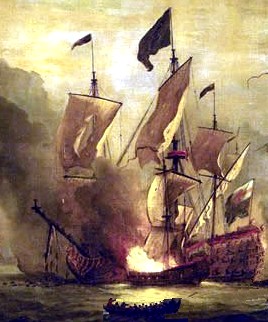
Artist: Willem van de Velde the Younger
Dutch Fire-ship Attack on the Royal James
at the Battle of Solebay (1672)
Exquemelin describes how Morgan had his buccaneers create the fire-ship used at Maracaibo:
First, he commanded all the slaves and prisoners to be tied, and guarded very well, and gather all the pitch, tar, and brimstone they could find in the whole town, for the fire-ship above mentioned; then they made several inventions of powder and Brimstone with palm-leaves, well anointed with [flammable] tar. They covered very well their counterfeit cannon [made from barrels], laying under every piece many pounds of powder; besides, they cut down many out-works of the ship, that the powder might exert its strength the better; breaking open, also, new port-holes, where, instead of guns, they placed little drums used by the negroes. Finally, the decks were handsomely beset with many pieces of wood, dressed up like men with hats, or monteras, and armed with swords, muskets, and bandeleers.5
James Watt explains some additional details of how fire-ships were constructed. He notes that fire-ships "were normally fitted with incendiary materials such as powder kegs, bitumen and cartridges. They had a row of ports in their lower decks, hinged at the bottom so that they could fall open allowing air to enter and feed the flames. At the last moment the crew would escape in a small boat to allow the blazing fire ship to drive onwards and ignite enemy vessels."6
1 Alexandre Exquemelin, The Buccaneers of America, 1853 Edition, p. 120; 2 Exquemelin, p. 121; 3 Edward Barlow, Barlow’s Journal of his Life at Sea in King’s Ships, East and West Indiamen & Other Merchantman From 1659 to 1703, p. 118; 4 Captain Charles Johnson, A general history of the pirates, 3rd Edition, p. 117; 5 Exquemelin, p. 120-1; 6 Vice-Admiral Sir James Watt, "The burns of seafarers under oars, sail and steam", Injury: the British Journal of Accident Surgery, Vol. 12, p. 71
Burning As Punishment
When people were captured by pirates or buccaneers, they would sometimes hide their valuables on the ship hoping that the pirates would ransack the ship and leave it without finding them. Unfortunately the rogues were familiar with this strategy. When they wanted information on where such valuables were stashed, they would sometimes resort to torture to get it.
Burning skin being quite painful, fire was sometimes used to convince prisoners to reveal the whereabouts of their loot. To convince prisoners at Maracaibo to reveal their hidden wealth, Captain Henry Morgan was reported to have "burning matches placed betwixt their fingers, which were thus burnt alive."1 At Gibraltar, Morgan "kindled palm-leaves, and applied the flame to the face of [an] unfortunate Portuguese, burning with them the whole skin, beard and hair."2
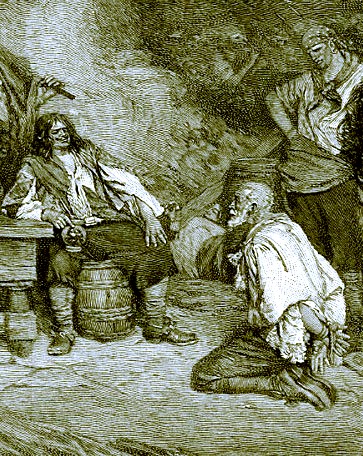
Artist: Howard Pyle - Morgan at Porto Bello (1888)
In a similar fashion, Johnson tells of how Edward Low "took a Sloop bound to Amboy, William Frazier, Master, with whom Mr. Low happening to be displeased, he ordered lighted Matches to be ty'd between the Mens Fingers, which burnt all the Flesh off the Bones; then cut them in several Parts of their Bodies with Knives and Cutlashes afterwards took all their Provisions away, and set some of them ashore in an uninhabited Part of the Country."3 Of course, pirates and buccaneers cared little what happened to such victims once they were done with them, so their healing was left to some surgeon other than the one kept by the pirates.
Burning was also used as a form of punishment. Aaron Smith, who was captured by Cuban pirates in 1822 explains such a punishment by the pirate captain. The captain felt the man was part of a mutinous crew, all the rest of whom had been shot and killed while approaching his ship in a long boat.
"On his being brought on board, the captain told [the lone survivor] the accusation that was against him, and his party, and threatened him with a cruel and lingering death, if he did not confess the whole truth. In vain did he declare his innocence, and ignorance of any plot; the ruffian was resolved to glut his vengeance, and ordered him to be stripped and exposed, naked, wounded, and bleeding as he was [from being shot at previously when returning from shore], to the scorching fervour of a July sun; the July sun of a tropical climate!"4
The man was tied naked in a rowboat and rowed back and forth in a creek for several hours in 90 degree heat. Eventually Smith reported that "his body began to swell, and he appeared one complete blister from head to foot."5 The man begged Smith to cure him, but the pirates would have none of it and decided to shoot and then sink the remains.
Of course, boys will be boys and since nearly all pirates were male, there was a bit of private torturous burning that occurred. "Alexander Smythe, a young surgeon’s mate serving in the HMS Vanguard in 1695, describes his treatment of large iatrogenic [surgically-caused] burns resulting from the application of numerous blistering plasters in an attempt to rouse a drunken colleague."6 It might truly be safer to 'keep your friends close, but keep your enemies closer' in such an environment.
1 Alexandre Exquemelin, The Buccaneers of America, 1856 Edition, p. 113; 2 Exquemelin, p. 115-6; 3 Captain Charles Johnson, A general history of the pirates, 3rd Edition, p. 380; 4 Aaron Smith, The Atrocities of the Pirates, p. 36-7; 5 Smith,p. 38; 6 Vice-Admiral Sir James Watt, "The burns of seafarers under oars, sail and steam", Injury: the British Journal of Accident Surgery, Vol. 12, p. 78

